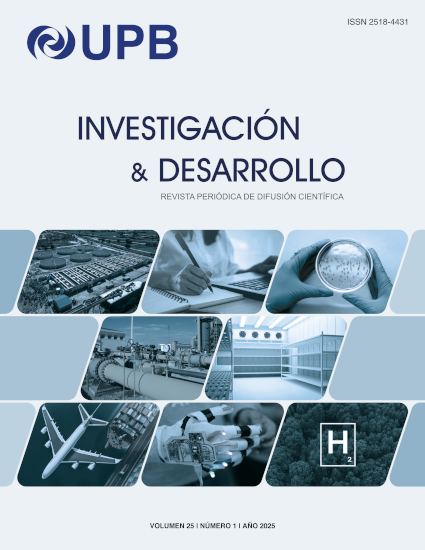COAGULATION–FLOCCULATION AS A POLISHING STRATEGY FOR SECONDARY EFFLUENTS IN MUNICIPAL WASTEWATER TREATMENT PLANTS
DOI:
https://doi.org/10.23881/idupbo.025.1-4iKeywords:
Wastewater, Effluent Quality, Coagulation-flocculation, PolishingAbstract
Efficient treatment of municipal wastewater faces challenges due to both the limitations of conventional technologies and rapid urban growth. To improve the quality of the secondary effluent from the Pucara wastewater treatment plant (WWTP) in Sacaba, coagulation-flocculation tests were conducted using aluminum sulfate, ferric chloride, and polyaluminum chloride (PAC) combined with an organic flocculant (FLOC). This process enhances the removal of colloidal solids and improves the reduction of organic matter. The tests were carried out using a low-cost jar test apparatus built with locally available materials. Although the plant currently achieves close to 90% efficiency in organic matter removal, its effluent (195 mg/L COD) does not comply with regulatory limits for discharge into the Rocha River (<60 mg/L COD). The optimal doses were 60 ppm of aluminum sulfate, 60 ppm of ferric chloride, and 40 ppm of PAC + 2 ppm of FLOC, achieving turbidity reductions between 73% and 79%, and residual COD values ranging from 93 to 141 mg/L. Ferric chloride showed the best overall performance, with an estimated daily requirement of 187 kg and the need for structural modifications, which highlights the importance of conducting a technical and economic feasibility analysis. The estimated sludge production was 93 m3/day, further reinforcing the need to assess the viability of its management from both technical and economic perspectives. Coagulation-flocculation emerges as a viable alternative for polishing secondary effluents in expanding urban areas, provided that proper operation is ensured and long-term sustainability is carefully evaluated.Downloads
References
[1] S. U. Bhat, U. Qayoom, S. U. Bhat, and U. Qayoom, “Implications of Sewage Discharge on Freshwater Ecosystems,” in Sewage - Recent Advances, New Perspectives and Applications, IntechOpen, 2021. doi: 10.5772/intechopen.100770.
[2] Millennium Ecosystem Assessment, Ed., Ecosystems and human well-being: synthesis. in The Millennium Ecosystem Assessment series. Washington, DC: Island Press, 2005.
[3] J. Mateo-Sagasta, S. M. Zadeh, H. Turral, and J. Burke, “Water pollution from agriculture: a global review. Executive summary,” 2017, Accessed: May 29, 2025. [Online]. Available: https://hdl.handle.net/10568/88070
[4] E. R. Jones, M. T. H. van Vliet, M. Qadir, and M. F. P. Bierkens, “Country-level and gridded estimates of wastewater production, collection, treatment and reuse,” Earth Syst. Sci. Data, vol. 13, no. 2, pp. 237–254, Feb. 2021, doi: 10.5194/essd-13-237-2021.
[5] M. Qadir et al., “The challenges of wastewater irrigation in developing countries,” Agric. Water Manag., vol. 97, no. 4, pp. 561–568, Apr. 2010, doi: 10.1016/j.agwat.2008.11.004.
[6] J.-M. Brault, K. Buchauer, and M. Gambrill, Wastewater Treatment and Reuse: A Guide to Help Small Towns Select Appropriate Options. World Bank, 2022. doi: 10.1596/37317.
[7] C. A. De Lemos Chernicharo, T. Bressani-Ribeiro, and D. A. Nolasco, Eds., Reactores Anaeróbicos para Tratamiento de Aguas Residuales: Diseño, Construcción y Operación. IWA Publishing, 2024. doi: 10.2166/9781789064261.
[8] Ministerio de Medio Ambiente y Agua, “Estrategia Nacional de Tratamiento de Aguas Residuales (ENTAR),” presented at the Presentación de la estrategia nacional de tratamiento de aguas residuales, La Paz-Bolivia, 2020.
[9] O. Saavedra et al., “Evaluation of a domestic wastewater treatment plant at an intermediate city in Cochabamba, Bolivia,” Water Pract. Technol., vol. 14, no. 4, pp. 908–920, Dec. 2019, doi: 10.2166/wpt.2019.071.
[10] I. Echeverría, O. Saavedra, R. Escalera, G. Heredia, C. Yoshimura, and R. Montoya, “Small-Scale Operation of an Integrated Anaerobic Baffled Reactor and Biofilter: Factors Affecting Its Performance,” J. Environ. Eng., vol. 148, no. 11, p. 04022065, Nov. 2022, doi: 10.1061/(ASCE)EE.1943-7870.0002047.
[11] J. Bratby, Coagulation and Flocculation in Water and Wastewater Treatment. IWA Publishing, 2016.
[12] N. Al-Jadabi, M. Laaouan, M. Benbouzid, J. Mabrouki, and S. El Hajjaji, “Coagulation-flocculation technique for domestic wastewater treatment in the city of Ain Aouda, Rabat, Morocco,” E3S Web Conf., vol. 337, p. 02003, 2022, doi: 10.1051/e3sconf/202233702003.
[13] Carrasco Quiroz, Carlos Alberto, “Tratamiento Físico Químico de Aguas Residuales,” Universidad de Chile, Santiago de Chile, 2007.
[14] K. O. Iwuozor, “Prospects and Challenges of Using Coagulation-Flocculation method in the treatment of Effluents,” Adv. J. Chem.-Sect. A, pp. 105–127, Jan. 2019, doi: 10.29088/SAMI/AJCA.2019.2.105127.
[15] “6 Station Portable Jar Testing Apparatus (Flocculation Tester), 120VAC, A&F Machine (each),” Nova-Tech International. Accessed: Jul. 24, 2025. [Online]. Available: https://www.novatech-usa.com/AFM-JM-6?srsltid=AfmBOooOQ_k1EZGM8iHbwb1nO5xrLlDjKbmub7ldVFdodjHmNiB9rZ0r&utm_source=chatgpt.com
[16] Gobierno Autónomo Municipal de Sacaba, “Plan territorial de Desarrollo Integral para Vivir Bien del municipio de Sacaba 2021-2025.” 2023. [Online]. Available: https://www.sacaba.gob.bo/images/wsacaba/pdf/gaceta/poa/PTDI2021-2025.pdf
[17] Gobierno Autónomo Municipal de Sacaba, “Ficha técnica Planta de tratamiento de Aguas Residuales Pucara.” 2022.
[18] APHA, AWWA, and WEF, Standard Methods for Examination of Water and Wastewater, 22nd ed. Washington: American Public Health Association, 2012.
[19] M. Pivokonský, K. Novotná, L. Čermáková, and R. Petříček, Jar Tests for Water Treatment Optimization: How to Perform Jar Tests – a handbook. IWA Publishing, 2022. doi: 10.2166/9781789062694.
[20] United States Environmental Protection Agency, “Technologies for Upgrading Existing or Designing New Drinking Water Treatment Facilities,” Office of Drinking Water, Center for Environmental Research Information, U.S. Environmental Protection Agency., Cincinnati, OH 45268, (EPA/625/4-89/023), 1990.
[21] United States Environmental Protection Agency, “Enhanced Coagulation and Enhanced Precipitative Softening Guidance Manual,” Office of Water, EPA 815-R-99-012, 1999.
[22] V. Matamoros and V. Salvadó, “Evaluation of a coagulation/flocculation-lamellar clarifier and filtration-UV-chlorination reactor for removing emerging contaminants at full-scale wastewater treatment plants in Spain,” J. Environ. Manage., vol. 117, pp. 96–102, Mar. 2013, doi: 10.1016/j.jenvman.2012.12.021.
Downloads
Additional Files
Published
Issue
Section
License
Copyright (c) 2025 Ivette Echeverría, Valeria Vargas

This work is licensed under a Creative Commons Attribution-NonCommercial-ShareAlike 4.0 International License.
Creative Commons Attribution-Noncommercial-Share Alike
CC BY-NC-SA
This license lets others remix, tweak, and build upon your work for non-commercial purposes, as long as they credit the author(s) and license their new creations under the identical terms.
The authors can enter additional separate contract agreements for non-exclusive distribution of the version of the article published in the magazine (for instance, they may publish it in an institutional repository or a book), subject to an acknowledgement of its initial publication in this magazine.
